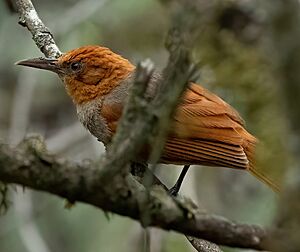Henna-hooded foliage-gleaner facts for kids
Quick facts for kids Henna-hooded foliage-gleaner |
|
|---|---|
 |
|
| Conservation status | |
| Scientific classification | |
| Genus: |
Clibanornis
|
| Species: |
erythrocephalus
|
 |
|
| Synonyms | |
|
Hylocryptus erythrocephalus |
|
The henna-hooded foliage-gleaner (Clibanornis erythrocephalus) is a special kind of bird found in Ecuador and Peru. It belongs to the ovenbird family, Furnariidae. This bird is considered Near Threatened, which means its population needs to be watched carefully.
Contents
About This Bird
This bird is part of a larger group called Clibanornis. Scientists used to think it belonged to other groups, but new studies show it fits best here. There are two main types, or subspecies, of the henna-hooded foliage-gleaner:
- C. e. erythrocephalus
- C. e. palamblae
What It Looks Like
The henna-hooded foliage-gleaner is about 21 cm (8.3 in) long and weighs around 48 g (1.7 oz). It's a fairly large bird with a strong, slightly curved beak. Both male and female birds look alike.
The most striking feature is its unique "henna" color. This means it has an orange-red head, neck, wings, and tail. Its back is a brownish-olive color. The underside of its body is mostly pale brownish-gray, with a reddish area near its tail.
Its eyes can be yellow or gray-brown. Its upper beak is gray or blackish-gray, while the lower beak is whitish or horn-colored with a dark tip. Its legs and feet are olive or gray.
The subspecies C. e. palamblae looks a bit different. Its "henna" parts are paler, and its back is grayer. Its chest and belly are also a lighter buff color.
Where It Lives
The henna-hooded foliage-gleaner lives in two separate areas. One group is found in west-central Ecuador. The other group lives further south in Ecuador and extends into northwestern Peru. The C. e. palamblae subspecies lives even further south in Peru.
This bird prefers to live in forests and woodlands that can be dry or slightly humid. It often lives on the lower slopes of the Andes mountains. It especially likes areas with many mallow plants. In Ecuador, you can find it at elevations between 400 and 1,800 meters (1,300 and 5,900 ft). In Peru, it lives between 400 and 1,500 meters (1,300 and 4,900 ft) high.
Behavior
Movement
This bird does not migrate. It stays in the same area all year round.
Feeding
The henna-hooded foliage-gleaner mainly eats small bugs and other creatures that live on the ground. It often searches for food alone or in pairs. Sometimes, it joins groups of different bird species that are also looking for food.
It finds its food by noisily flipping over leaves and digging through leaf litter on the ground. It also probes among dead leaves and tangled vines.
Reproduction
The breeding season for this bird is from January to May. Both the male and female birds work together to dig a burrow in a shaded dirt bank. At the end of this burrow, they build a nest using rootlets and other plant fibers.
So far, all known nests have had three eggs. The eggs hatch after 16 to 19 days. Scientists are still learning about how long it takes for the young birds to leave the nest and how the parents care for them.
Vocalization
The song of the henna-hooded foliage-gleaner can be heard from far away. It sounds like a fast, chattering "kree-kruh-kruh-kruh-kruh-kruh-kruh-kurr" with a unique, mechanical sound. It also has a distinct, short, sharp, high-pitched call.
Status and Conservation
The henna-hooded foliage-gleaner is currently listed as Near Threatened. This means that while it's not in immediate danger, its population is decreasing. There are an estimated 2,500 to 10,000 adult birds left.
The biggest threat to this bird is the loss of its home. Forests are being cut down, even in protected areas. People are settling in these areas, clearing land for farming, and allowing livestock to graze. These activities disturb the birds and can even cause their nests to fail. Protecting their habitat is very important to help this species survive.


